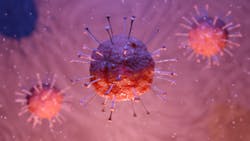Time is not on our side with visible-light disinfection (MAGAZINE)
What a difference a year makes. One year ago, my wife and I were going through disinfectant wipes like crazy. Delivered packages and every item from the grocery had to be wiped clean. For good measure, I placed things not needed immediately in the garage, allowing time to take care of any invisible pathogen. The science was certain that surface contamination was the predominant mode for transmission of the coronavirus. It was a spate of announcements of visible-light disinfection products based on violet radiation that brought the memory to front of mind.
Realistically, we should have known better. I remember the first widely-publicized instance of transmission among a large group of people in the US was traced to a choir practice in a crowded indoor space. Clearly, it was transmission via the air that was causing the rapid spread. Mask recommendations and mandates came far too late.
Going back that year, I was optimistic that visible-light disinfection could help slow the pandemic. But little research had been done on how the technology would perform with a viral pathogen. It had been studied extensively with bacterial and fungal pathogens. The disinfection technology was already in mainstream use in places like athletic locker rooms where staph remains a problem.
Meanwhile, ultraviolet (UV) radiation in the UV-C (100–280 nm) band had long been known to deactivate viruses. As I wrote about in a recent special report, UV-C had been used extensively in tuberculosis wards and helped curb a major outbreak. Still, UV-C must be carefully deployed as we have discussed repeatedly.
Ideally, society will leverage multiple forms of UV-C technology and visible-light disinfection technology going forward. But where I thought a year ago that the visible-light technology would have been a great tool for fighting the coronavirus, the technology will not likely help with airborne transmission of a pathogen. It simply takes too long to deactivate a virus. That aforementioned choir practice could have taken place in a room lit with violet-radiating luminaires that are safe for people, and still most would have gotten ill.
Still, I applaud the hard work and accelerated effort that research institutions and manufacturers have invested in documenting the anti-viral capabilities of violet light. We now know what it can do. And who knows when and how the next pandemic will happen and spread. I think we are most all convinced at this point that there will be another one. I sincerely hope we will be better prepared on all fronts.
Meanwhile, we will have another special report on UV-C technology in our next issue. We will focus on deployment in commercial buildings. That application area is a bit strange at this time because so many of us are not in offices. I sense, however, that the return is underway. I cannot repeat enough that we need to be prepared.
If any of you in the audience have an interesting angle on a commercial UV-C deployment, send me an email at my address listed down below. I would love to find proven projects that are safely protecting people who work in or just traverse a space.
Maury Wright
EDITOR
Enjoyed this article? Visit our digital magazine for more like this >>

Maury Wright | Editor in Chief
Maury Wright is an electronics engineer turned technology journalist, who has focused specifically on the LED & Lighting industry for the past decade. Wright first wrote for LEDs Magazine as a contractor in 2010, and took over as Editor-in-Chief in 2012. He has broad experience in technology areas ranging from microprocessors to digital media to wireless networks that he gained over 30 years in the trade press. Wright has experience running global editorial operations, such as during his tenure as worldwide editorial director of EDN Magazine, and has been instrumental in launching publication websites going back to the earliest days of the Internet. Wright has won numerous industry awards, including multiple ASBPE national awards for B2B journalism excellence, and has received finalist recognition for LEDs Magazine in the FOLIO Eddie Awards. He received a BS in electrical engineering from Auburn University.





![The DesignLights Consortium continues to make progress in shifting outdoor lighting products and implementation practices toward a more restrained and thoughtful strategy. [Image does not represent a DLC qualified fixture.] The DesignLights Consortium continues to make progress in shifting outdoor lighting products and implementation practices toward a more restrained and thoughtful strategy. [Image does not represent a DLC qualified fixture.]](https://img.ledsmagazine.com/files/base/ebm/leds/image/2024/08/66be810888ae93f656446f61-dreamstime_m_265700653.png?auto=format,compress&fit=&q=45&h=139&height=139&w=250&width=250)
